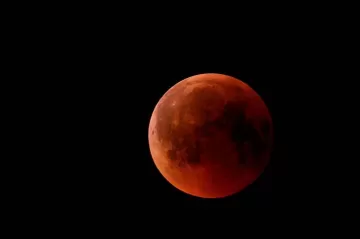The last lunar eclipse is recognized as the "longest in centuries" by NASA

The last lunar eclipse is recognized as the "longest in centuries" by NASA
There hasnt been a longest partial lunar eclipse since February 18, 1440. But not all experts agree. Find out why.
Citizens of Africa, America, the Pacific, Oceania and Asia were able to enjoy this Friday a partial lunar eclipse that lasted 208 minutes and 23 seconds, a phenomenon that could not be seen practically in Europe .
A lunar eclipse occurs when the Earth stands between the Sun and the Moon , casting a shadow that obscures our satellite; for this it is necessary that the three objects are aligned.
Although the partial eclipse lasted 3 hours and 28 minutes - the time that a dark part of the Moon is observed - the total phenomenon - penumbra eclipse - began at 06:02 GMT and ended at 12:04 GMT, according to data from the US space agency NASA.
In reality, this eclipse has been almost total, with an occultation rate of 97 percent ; its maximum took place around 09:00 GMT.
The partial eclipse was visible in the westernmost tip of Europe, America, the Pacific, Oceania, and eastern Asia . In its last phases, in North America, also in the Pacific, Oceania and much of Asia, explains the National Geographic Institute on its website.
On its website, NASA makes a comparison of the duration of this partial eclipse with other past ones of the same category.
It is, he says, the longest partial lunar eclipse in centuries , with a duration of 3 hours, 28 minutes and 23 seconds.
There has been no longest partial lunar eclipse since February 18, 1440 (3 hours, 28 minutes and 46 seconds) and it will remain the longest partial for 648 years, until February 8, 2669 (3 hours, 30 minutes and 2 seconds).
However, there will be a longer total lunar eclipse on November 8, 2022.
But not all experts agree and the director of the Pamplona Planetarium (northern Spain), Javier Armentia, complains about this "astronomical yellowishness".
“Many total eclipses are longer, for one thing. And then there are like a hundred that are only a second shorter "he says on his Twitter account and wonders that then" why so much? ". His answer: so that the note has more shine in the networks, “pure clickbait”.
For this astronomer, “only from the deepest ignorance of what an eclipse is can anyone point out that the total duration of a partial eclipse is relevant. It never was, but it seems that before the control criteria for what is said publicly were stricter ”. (I)
Eclipse, blood moon and supermoon: when and how to see them
The lunar eclipse of this May 26 is one of the most outstanding astronomical events of 2021. There will also be a supermoon
There will be a total lunar eclipse, also known as a blood moon , which will be visible in the Americas, the Pacific, Oceania, and Asia . According to NASA , it is given this nickname for its red glow in the night sky when such an eclipse occurs.
This event coincides with the Supermoon of flowers , the name given to a full moon in the middle of the boreal spring.
Where and how to see the blood moon
The blood moon or the total lunar eclipse of this May 26 can be seen in the western part of South America, precisely in Ecuador, Peru, Chile, Argentina and Uruguay, in part of Central America and in the western United States. , as well as in Oceania and some parts of Asia.
The phenomenon of the blood or red moon will take place twice this year . His second appearance will be on November 19. To be able to appreciate the eclipse, it will only be enough with a clear sky, without clouds . It can be seen with the naked eye or also with the help of a basic telescope or binoculars.
Time of the eclipse
According to the Astronomical Observatory of Quito (OAQ), this astronomical phenomenon will begin at 03:47 (continental Ecuador time) in the early morning of Wednesday, May 26 . The maximum of the eclipse will occur at 06:18 in the morning, when the Moon is at an altitude of -3 °, and the last penumbral contact (end of the eclipse) will take place at 08:49.
In the case of the Galapagos Islands, the maximum of the eclipse will occur at 06:19 and the Moon will be at a height of 9 ° above the horizon, which makes the islands an excellent place to observe the eclipse, according to the observatory.
The OAQ points out that this observation will only be possible if the meteorological conditions allow it, that is, if a clear sky can be counted on . If these conditions are met, they will broadcast the observation of the eclipse, live, through their Facebook page Astronomical Observatory of Quito .
flower superluna
The Astronomical Observatory of Quito also indicates that the moon of this May 26 will be in its full moon phase with a magnitude of -12.41. The approximate distance between the Moon and the center of the Earth will be 354,000 kilometers (perigee) and its surface will be 100% illuminated.
Being in perigee, the May full moon turns into a supermoon, called the flower moon by natives of the northeastern United States, because of the abundance of flowers in the spring. That is, this full moon will appear larger and brighter than usual. It can be seen on the night of May 26 .
